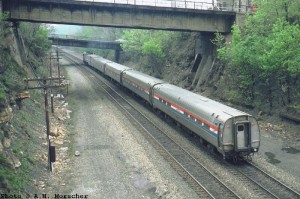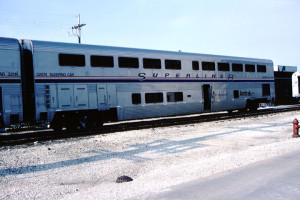There’s Good News and There’s Bad News
As I’ve mentioned on several other occasions, Amtrak’s ridership is up. Way up. In July of this year, Amtrak carried 2,750,278 people. That’s more people than the railroad has carried in a single month ever – Ever! – and it was a 14 percent increase over July of last year.
What accounts for this rush to rail? “Increasing [gas] prices, highway congestion, airline issues and environmental awareness … ,” says Alex Kummant, President and CEO of Amtrak.
 Here are the figures for some of the routes most affected:
Here are the figures for some of the routes most affected:
Acela – up 5.5 percent
Northeast regional service – up 8.8 percent
The Downeaster – up 33.6 percent
The Keystone Service – up 19.9 percent.
The Piedmont – up 43 percent
The Heartland Flyer – up 40.2 percent
The Hiawatha Service – up 37.7 percent
The San Joaquins – up 32.1 percent
The Coast Starlight – up 27.7 percent
The Silver Meteor – up 14.7
The Silver Star – up 17.8 percent
Revenue from tickets is up by more than 14 percent. And Amtrak is projecting a total ridership of 28 million people by the end of this year. Wow! That really is good news!
But – and there’s always a “but” isn’t there? – all these new riders mean Amtrak trains are crowded … to the point that people have to stand for extended periods on some routes. What should be relaxing travel is becoming a less than pleasant experience for an ever-growing number of passengers.
 The trouble is, Amtrak can’t just add more trains because it simply doesn’t have the extra rail cars or the locomotives to haul them. In fact, there are more than 100 coaches and sleeping cars sitting in storage and all it would take to get them back in service is for Amtrak to perform required maintenance on some and do minor repairs on the rest. So why hasn’t this been done? Because there is no money to do it.
The trouble is, Amtrak can’t just add more trains because it simply doesn’t have the extra rail cars or the locomotives to haul them. In fact, there are more than 100 coaches and sleeping cars sitting in storage and all it would take to get them back in service is for Amtrak to perform required maintenance on some and do minor repairs on the rest. So why hasn’t this been done? Because there is no money to do it.
So the traveling and commuting public is paying the price for the short-sightedness of a federal government which has thrown money into roads and the airlines, and deliberately tried to starve Amtrak to death over the past 20-plus years.
Maybe it’s time for a change in Washington’s approach to passenger rail service.
Ya think??



Yes, the big thing about HR6003 – in addition to more money than they’ve had before – is the five-year commitment. Unfortunately, Congress adjourned before acting on it. Also, Dick Durbin (Illinois senator) is proposing additional legislation this would provide funds specifically for more equipment – both new and repair of old. At least that’s my understanding.
Jim, do you have a sense of the effect the recent legislation (HR6003?) will have on this? My impression was that it provided additional funding over previous years.
And I ask with the realization that it will be at least a few months before even the cars out of service for want of inspections could return. Nature of the beast w/ govvie contracting.
Something that’s interesting about the statistics you cite is that they’re all for regional or major metro area service.
Definitely time for some congressional types to sit up and take notice!